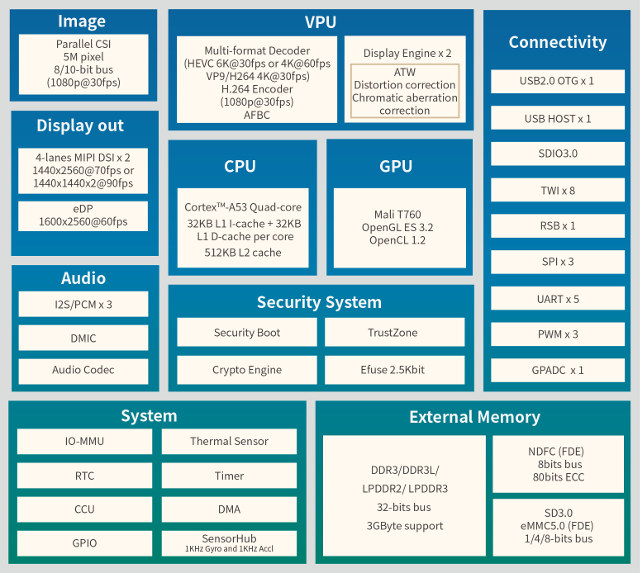Virtual reality headsets have been powered by application processors designed for smartphones, tablets, or even TV boxes. For example last year, I reviewed a low cost VR headset good enough to watch 360 / VR videos, but not gaming that was based on Allwinner H8 TV box processor.
But we’ve previously seen Allwinner was working on VR9 & VR10 processors specifically designed for virtual reality headsets with launches scheduled for Q4 2016 and Q2 2017. There’s obviously been some delays, but the company also now formally launched Allwinner VR9 quad core Cortex A53 processor specifically designed for XR and VR headset (Extended / Virtual reality).

Allwinner VR9 key features & specifications with parts that look specific to XR/VR highlighted in bold:
- CPU – Quad-Core Arm CortexM-A53 @ 1.8GHz with 32KB L1 I-cache + 32KB L1 D-cache per core, 512KB L2 cache, CoolFlex power management architecture
- GPU – Arm Mali-T760 @ 624MHz with supports for OpenGL ES3.2/3.1/3.0/2.0/1.1, DirectX11.1, OpenCL 1.2/1.1 and Renderscript
- Memory I/F – 32-bit DDR3/DDR3L/LPDDR3/LPDDR2
- Storage I/F
- eMMC 5.0 with support for Full Disk Encryption (FDE)
- 8-bit TLC/MLC/SLC/EF NAND flash with 80-bit ECC, FDE
- Video
- Decoder – HEVC decoder 6K@30fps,4K@60fps; H.264/ VP9 decoder 4K@30fps; multi-format 1080P@60fps video playback, including VP8,MPEG1/2, MPEG4 SP/ASP L5,H.263, WMV9/VC-1
- Encoder – H264 HP encoder 1080P@30fps
- JPEG encoder up to 4096×4096
- Camera
- 8-/10-bit DC interface up to 5M, 1080p @ 30 fps
- BT656 interface
- ITU-R BT.656 time-multiplexed format
- Audio
- Stereo ADC and DAC
- 5x analog audio inputs and 3x analog audio outputs
- Capless headphone driver
- Display
- Dual Display Engine for high-end VR
- 2x 4-lane MIPI DSI up to 1440×2560 @ 70fps or 1440x1440x2 @ 90fps
- eDP up to 1600×2560 @ 60 fps
- SmartColorTM3.0 for excellent display experience
- Supports Frame Packing/Top-and-Bottom/Side-by-Side Full/Side-by-Side Half 3D format data
- Hardware accelerator “Portal ”for ATW, distortion correctionchromatic aberration correction
- Sensors
- Built-in Sensor Hub
- Supports 9-axis sensor, including accelerometer, gyroscope, magnetometer
- Supports ambient light and proximity sensor
- USB – USB Host, USB 2.0 OTG
- Other I/Os – SDIO 3.0, RSB, 8x TWI,3x SPI, 5x UART, 3x PWM, GPADC
- Companion Chip – Customized AXP802 PMIC
- Package – FCBGA 463, 15mm x 15mm size, 0.65 pitch, 0.35 ball size
- Process – 28nm HPC
The specifications on Allwinner website also list 802.11 a/b/g/n/ac WiFi, but it’s not shown on the block diagram, so it must be through an external module via the SDIO interface. Latency is said to be as low as 20ms, and the platform may eventually be used in headsets that combine 5G, artificial intelligence and mobile edge computing (MEC). The sensor hub enables up to 6 DoF (degrees of freedom) to track the user movements.
The company provides support for Android 7.1 and above for the chip. Some products are already ready for distributions, as we can see from Charbax video below about Emdoor Allwinner VR9 headset.
The design house explains VR9 headset is mostly suitable for VR videos, may not be suitable for virtual gaming as Qualcomm Snapdragon 845, but will be more affordable. No exact price was given, but it will be below $200.

Jean-Luc started CNX Software in 2010 as a part-time endeavor, before quitting his job as a software engineering manager, and starting to write daily news, and reviews full time later in 2011.
Support CNX Software! Donate via cryptocurrencies, become a Patron on Patreon, or purchase goods on Amazon or Aliexpress




